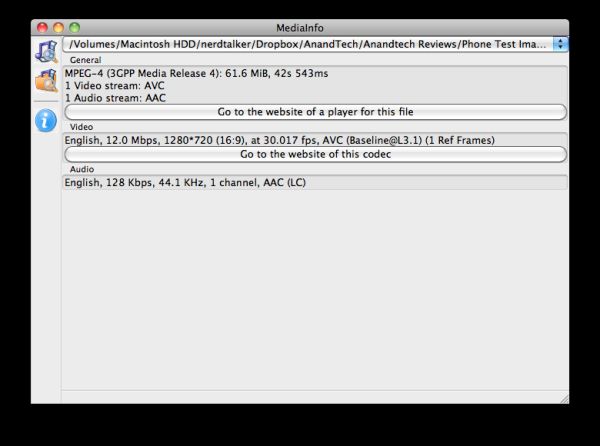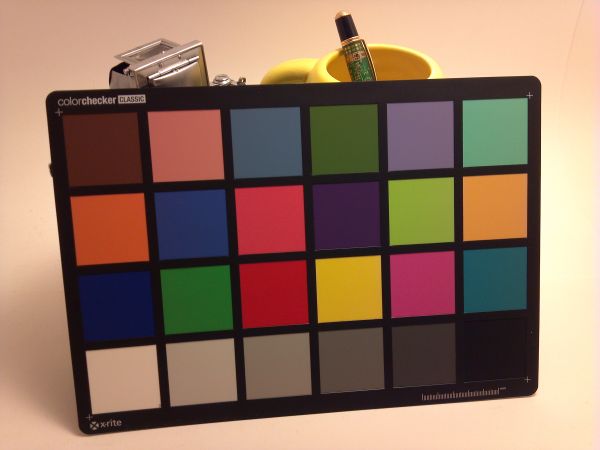Motorola Droid X2 Review - A Droid X with Tegra 2
by Brian Klug on July 7, 2011 8:31 AM ESTCamera - Upgraded
Captured image quality is getting better with time, thanks to both improved image signal processing (ISP), software, optics, and of course sensors. Thankfully the X2 brings the entire package of improvements to the table. First off, the most obvious difference is that the mechanical shutter is gone (whose purpose I never quite understood), and the first vertex of the camera seems to have a larger diameter, meaning it has improved light collection over the X.
The original X was one of the first smartphones we tested with 720p video capture after the iPhone 4 made its debut. At that time, the X captured 720p24 8 Mbps MPEG-4 video with 1 channel 96 Kbps AAC audio. The X2 bumps video capture up to 720p30 H.264 at 12 Mbps with 128 Kbps single channel AAC audio.
Obviously the Tegra 2 SoC inside the Droid X2 could capture at 1080p, but we’d honestly rather see high quality 720p like the X2 shoots over lower bitrate 1080p. Honestly, 1080p still remains a checkbox feature today until bitrates get higher or encoders get better.
I initially noticed a serious problem with video capture on the X2. Set to capture to the external SD card (by default), video had second long dropouts and stalls, like this. Around 12 and 19 seconds, the fun starts:
On the device itself, capture would correspondingly pause, hang, and even crashed once. I shot two or three videos to confirm to myself that it wasn’t just a fluke, and also closed every application to see if RAM consumption was a problem. After some googling and discovering similar complaints on forums, I stumbled on the problem - set the capture destination to internal storage, and the stuttering goes away. I went and re-captured the video, and boom, no stuttering:
What’s curious about the whole thing is that the card shouldn’t be the problem. I tested the 8 GB class 4 microSD card inside the X2 (which comes preinstalled) in a new USB 3.0 Lexar card reader with CrystalDiskMark and found that it had sequential writes of just over 5 MB/s. Far more than the 1.5 MB/s which would be required for the X2’s 720p video + audio stream. Testing with a 32 GB class 2 resulted in no stuttering, and after a format the supplied microSD card went back to not stuttering. Either way, if you experience problems, switch to internal storage, format the external, or get another microSD card.
The X2 includes an 8 MP camera with dual LED flash, just like the previous X. However, there’s more to image quality than just MP numbers, which would have you thinking that everything is the same.
Still image quality on the X2 is improved from the original Droid X. In some ways it’s considerably better, others the same.
White balance in our lighbox test is a bit warm, as are a few outdoors test shots. There’s some chromatic aberration at the extreme angles in the lightbox test as well, evidenced by the red circle around the image. That said overall sharpness seems better.
What I miss from the Droid X is that camera button, which (as I mention in the video review) Motorola seriously emphasized the first time around as a distinguishing feature for the X. The problem isn't so much that it's gone as it is that the camera software now relies on an awkwardly placed software capture button. What I mean is that the X2 uses the exact same camera UI as the original X, which obviously was tailored around using the shutter button instead of the software shutter button. As a result, more often than not I would press near (but not on) the button and just toggle the OSD instead of taking a photo.






































72 Comments
View All Comments
Hrel - Thursday, July 7, 2011 - link
I'd like to see them add an attachable/detachable slide out keyboard. Then they could also add a gamepad for actual hand held gaming. And they'd get to make money selling more accesories. It's a win for everyone! The thing is so thin as it is it can stand to gain some thickness without being an issue AT ALL.snoozemode - Thursday, July 7, 2011 - link
what do you mean, u cant see the grainy pattern in blue color? i see it just as good as in green, download the engadget app and put the icon on the homescreen, tons of black spots in it where the white subpixels have closed. RGBW sucks, period.bjacobson - Thursday, July 7, 2011 - link
all these high powered phones but scrolling up and down with your finger on a webpage is still laggy as hell. ???bplewis24 - Friday, July 8, 2011 - link
They're displaying flash images...what do you expect?JayQ330 - Thursday, September 1, 2011 - link
you have to download a gpu rendering browser, its the reason the iphone & samsung galaxy s2 & even the s are able to scroll & zoom in & out so smooth, when you see checker board effect you know its gpu rendered where as the regular android browsers are constantly resizing & adjusting words & images in realtime. they should take a hint from samsungs browser.NeoteriX - Thursday, July 7, 2011 - link
If I was looking on my HTC Evo 3D, what text would I be searching for in the dmesg output to identify the camera initialization line?Brian Klug - Thursday, July 7, 2011 - link
Things like this:<4>[ 14.364959] __s5k3h1gx_probe
<6>[ 14.365051] s5k3h1gx_vreg_enable camera vreg on
<6>[ 14.365173] sensor_vreg_on camera vreg on
<6>[ 14.365722] sensor_power_enable("gp4", 2850) == 0
<6>[ 14.366180] sensor_power_enable("gp6", 2850) == 0
...
<6>[ 14.463897] s5k3h1gx_probe successed! rc = 0
<6>[ 14.464141] ov8810 s->node 1
<6>[ 14.464324] s5k3h1gx: s5k3h1gx_sensor_probe: switch clk
<6>[ 14.464416] Doing clk switch (s5k3h1gx)
<6>[ 14.484527] [Camera] gpio_request(30, "s5k3h1gx")
Note the part with OV8810 which is an omnivision 8 MP 1/3.2" sensor. Possibly the Sensation uses some parts Samsung, some parts OV.
YoPete525 - Thursday, July 7, 2011 - link
Great review as always, but I still find it ironic how far software optimization has to come on Android in general. I realize the X2 is rendering 26%(?) more pixels, but for every time it appears to process actions more quickly than the X, there is an example of it falling behind, like when pulling up the menu with the hardware button, and loading Basemark from the app drawer. Also, if you were to load up one of the more scrolling-conscientious launchers from the market, like LauncherPro or Go Launcher, the homescreens would scroll essentially at the device's refresh rate without stutter. Same story with Opera Mobile vs. the stock browser.NeoteriX - Thursday, July 7, 2011 - link
As I thought when I first looked at the dsmeg output; looks like it's no dice -- where the sensor ID should be is only "sp3d":<6>[73834.064016] [CAM]sp3d_vreg_enable camera vreg on
<6>[73834.064139] [Camera]Shooter_sp3d_vreg_on
...
<6>[73837.130660] [CAM]sp3d_spi_open_init: 1697
<6>[73837.130691] [CAM]sp3d_vreg_enable camera vreg on
<6>[73837.130691] [Camera]Shooter_sp3d_vreg_on
<6>[73837.132155] [CAM]sp3d: sp3d_sensor_probe: switch clk
<6>[73837.163436] [CAM]sp3d_sensor_setting type:0 config:0
Thoughts?
BTW, for what it's worth, the HTC Evo 4G uses the OV8810 omnivision for its camera:
<6>[690609.827789] [CAM]ov8810_resume
wpwoodjr - Thursday, July 7, 2011 - link
The effective available RAM memory on the DX2 is about 70-80mb less than the DX, you can see this by looking at Settings...Applications...Running Services and adding up the used and free memory. I was all set to buy a DX2 until I saw this. Even in the store I could easily make the Moto launcher close and be forced to redraw with only a few programs open. My DX already runs out of memory, I didn't want more problems. Perhaps this memory is taken up by the graphics card?It would be great if you added some multi-tasking tests to your reviews that would stress memory.